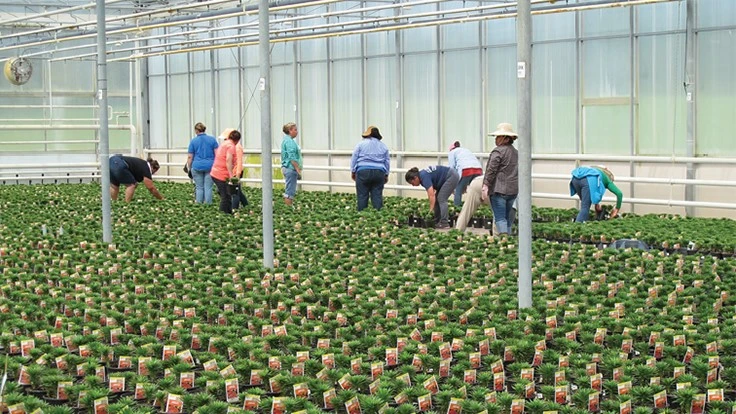

Greenhouse designs come in an assortment of shapes and sizes. Many companies have their own design departments and use their own approaches, making for a varied field in terms of structures, designs, dimensions and components, says A.J. Both, associate extension specialist in the Department of Environmental Sciences at Rutgers University.
It is important for the greenhouse industry to continue to create and vet standards and guidelines, which outline everything from heater placements to pad-to-fan distances to wind loads, Both says. They allow growers to understand the practices and procedures they need to follow when they apply for a permit.
“If you want to either remodel or you want to build something new, you have to go to your local zoning board and you apply for a permit, and that’s when a building inspector and a zoning board will look at your plans and decide whether you meet their requirements or not,” he says.
Both and others have developed standards for greenhouses to use, and those standards have largely worked. Over time, however, standards need to be reaffirmed or revised. And currently, securing funding to do research to check facts and figures can be difficult.

“Some of the standards that have been on the books for quite some time have now expired — mostly because of resources, but also because of, to a certain extent, people’s willingness to participate,” Both says. “We have not been able to update and maintain these standards. I think that’s a loss.”
Creating and vetting greenhouse standards and guidelines is a volunteer activity, Both says, as it helps the entire industry, not just specific growers or manufacturers.
“I think nobody has it in their job description [that they are] going to spend some of the time on this particular activity,” he says.
Standard revisions
Standards and guidelines need to be revised for two reasons, Both says.
“The first reason is obviously that we have new materials or new approaches or new insights that we can use to do things differently, and that needs to be eventually incorporated into the standards if they turn out to be good practices that make sense or save energy or save labor or whatever it is,” he says. “The other reason is that if we develop these standards, we typically do it through professional organizations.”
Organizations such as the American Society of Agricultural and Biological Engineers develop standards. Those organizations need to follow rules if they want to write a standard that is recognized by the American National Standards Institute, a non-profit organization that oversees the consensus of standards for a varety of products, services and systems in the U.S.

It is best to write a standard with the goal of getting it approved by the ANSI, Both says.
“It’s just like an accredited program of study,” Both says. “You go through a procedure; you follow certain rules. Those rules have been vetted and that means that there are some assurances that the process was followed correctly, that the right amount of people have provided inputs and that hopefully the right science and the right thinking went into the whole process to develop these standards.”
One of the rules involved in the process is that standards have to be either reaffirmed or updated every five years. If an update is necessary, teams of volunteers will work through changing and vetting standards until they come out with a consensus document that then gets approved for the next five years.
Different definitions
It is also important for the greenhouse industry to create and update its own standards to help avoid misunderstandings with regulators outside the industry, Both says.
For instance, building, electrical and fire safety codes are usually developed under the ISO’s rules and regulations, and they apply to all structures, he says. For this reason, municipalities and building inspectors often are first look at them. However, greenhouses are unique structures with distinctive applications.
“If they are not sufficiently described and identified in these very broad standards, then you can get a very difficult situation where a building inspector says, ‘No, you have to insulate your greenhouse because that’s what it says in the International Building Code’ — where it doesn’t make any sense to insulate a greenhouse because we want as much light in as possible,” he says. “Those things happen, and we typically have to do some education then.”
Growers should participate in the process of drafting and vetting standards and guidelines, possibly by forming an ad hoc committee, Both says.
“They don’t necessarily have to be all involved, but I think it’s important for them to have a voice because these standards — once they get approved — will have an impact on how their operations are running and what they can and cannot do,” he says. “I’m always of the mindset that it’s better to be involved in a discussion before new regulations are implemented because now you can provide input and you can object to certain clauses or certain ideas.”

Explore the July 2019 Issue
Check out more from this issue and find your next story to read.
Latest from Greenhouse Management
- Anthura acquires Bromelia assets from Corn. Bak in Netherlands
- Top 10 stories for National Poinsettia Day
- Langendoen Mechanical hosts open house to showcase new greenhouse build
- Conor Foy joins EHR's national sales team
- Pantone announces its 2026 Color of the Year
- Syngenta granted federal registration for Trefinti nematicide/fungicide in ornamental market
- A legacy of influence
- HILA 2025 video highlights: John Gaydos of Proven Winners





